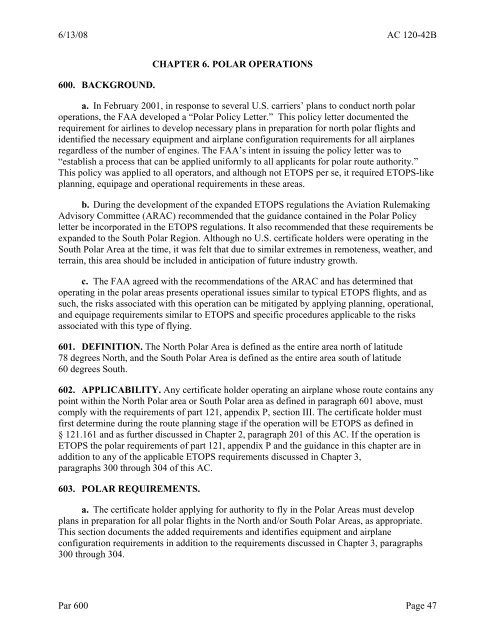AC 120-42B ETOPS and Polar Ops - Code7700
AC 120-42B ETOPS and Polar Ops - Code7700
AC 120-42B ETOPS and Polar Ops - Code7700
You also want an ePaper? Increase the reach of your titles
YUMPU automatically turns print PDFs into web optimized ePapers that Google loves.
6/13/08 <strong>AC</strong> <strong>120</strong>-<strong>42B</strong>600. B<strong>AC</strong>KGROUND.CHAPTER 6. POLAR OPERATIONSa. In February 2001, in response to several U.S. carriers’ plans to conduct north polaroperations, the FAA developed a “<strong>Polar</strong> Policy Letter.” This policy letter documented therequirement for airlines to develop necessary plans in preparation for north polar flights <strong>and</strong>identified the necessary equipment <strong>and</strong> airplane configuration requirements for all airplanesregardless of the number of engines. The FAA’s intent in issuing the policy letter was to“establish a process that can be applied uniformly to all applicants for polar route authority.”This policy was applied to all operators, <strong>and</strong> although not <strong>ETOPS</strong> per se, it required <strong>ETOPS</strong>-likeplanning, equipage <strong>and</strong> operational requirements in these areas.b. During the development of the exp<strong>and</strong>ed <strong>ETOPS</strong> regulations the Aviation RulemakingAdvisory Committee (AR<strong>AC</strong>) recommended that the guidance contained in the <strong>Polar</strong> Policyletter be incorporated in the <strong>ETOPS</strong> regulations. It also recommended that these requirements beexp<strong>and</strong>ed to the South <strong>Polar</strong> Region. Although no U.S. certificate holders were operating in theSouth <strong>Polar</strong> Area at the time, it was felt that due to similar extremes in remoteness, weather, <strong>and</strong>terrain, this area should be included in anticipation of future industry growth.c. The FAA agreed with the recommendations of the AR<strong>AC</strong> <strong>and</strong> has determined thatoperating in the polar areas presents operational issues similar to typical <strong>ETOPS</strong> flights, <strong>and</strong> assuch, the risks associated with this operation can be mitigated by applying planning, operational,<strong>and</strong> equipage requirements similar to <strong>ETOPS</strong> <strong>and</strong> specific procedures applicable to the risksassociated with this type of flying.601. DEFINITION. The North <strong>Polar</strong> Area is defined as the entire area north of latitude78 degrees North, <strong>and</strong> the South <strong>Polar</strong> Area is defined as the entire area south of latitude60 degrees South.602. APPLICABILITY. Any certificate holder operating an airplane whose route contains anypoint within the North <strong>Polar</strong> area or South <strong>Polar</strong> area as defined in paragraph 601 above, mustcomply with the requirements of part 121, appendix P, section III. The certificate holder mustfirst determine during the route planning stage if the operation will be <strong>ETOPS</strong> as defined in§ 121.161 <strong>and</strong> as further discussed in Chapter 2, paragraph 201 of this <strong>AC</strong>. If the operation is<strong>ETOPS</strong> the polar requirements of part 121, appendix P <strong>and</strong> the guidance in this chapter are inaddition to any of the applicable <strong>ETOPS</strong> requirements discussed in Chapter 3,paragraphs 300 through 304 of this <strong>AC</strong>.603. POLAR REQUIREMENTS.a. The certificate holder applying for authority to fly in the <strong>Polar</strong> Areas must developplans in preparation for all polar flights in the North <strong>and</strong>/or South <strong>Polar</strong> Areas, as appropriate.This section documents the added requirements <strong>and</strong> identifies equipment <strong>and</strong> airplaneconfiguration requirements in addition to the requirements discussed in Chapter 3, paragraphs300 through 304.Par 600 Page 47
















